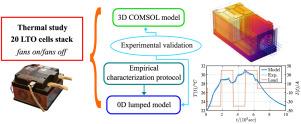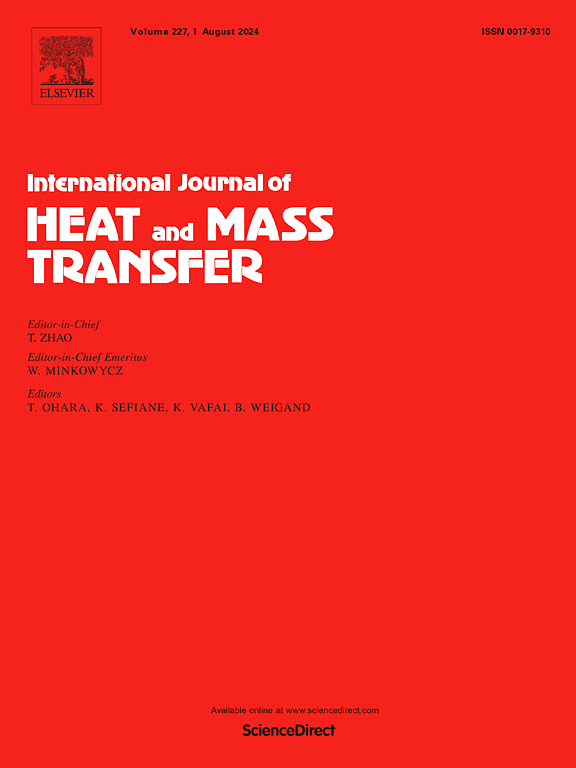LTO 电池模块的热研究:实验、三维数值分析和模型阶数缩减
IF 5
2区 工程技术
Q1 ENGINEERING, MECHANICAL
International Journal of Heat and Mass Transfer
Pub Date : 2024-11-14
DOI:10.1016/j.ijheatmasstransfer.2024.126407
引用次数: 0
摘要
了解和控制锂离子电池的温度变化对保持高性能、确保长循环寿命和避免热滥用至关重要。本文对装有 20 节棱柱型钛酸锂氧化物电池的风冷工业模块进行了数值和实验热分析。首先,本文提出了一个三维数值模型,用于研究冷却风扇开启或关闭时模块温度的动态分布。数值结果与试验台测量结果进行了验证。流场研究解释了电池片之间温度分布不均的原因。模块内部自然对流的计算,即风扇关闭时,通过精细的经验调整得以解决。在三维模型结果的基础上,利用模型阶次缩减(MOR)技术和能量平衡微分方程,开发出了一个 0D 块状模型。该模型的特点是对来自直接测试协议的模块实验数据进行调整。在 Simulink 上实施的 0D MOR 模型能够快速预测电池的最高温度,从而轻松精确地控制模块温度,误差为 1 °C。本文章由计算机程序翻译,如有差异,请以英文原文为准。

Thermal study on a LTO cell module: Experiment, 3D numerical analysis and model order reduction
Understanding and controlling the temperature evolution of Lithium-ion batteries is crucial to maintain high performance, ensuring long cycling life and avoiding thermal abuse. This paper presents a numerical and experimental thermal analysis of an air-cooled industrial module provided with 20 prismatic lithium-titanate-oxide cells. First, a 3D numerical model is presented for studying the dynamic distribution of the module temperature when the cooling fans are turned on or off. The numerical results are validated against test bench measurements. The flow field investigation explains the uneven temperature distribution among cells. The computation in natural convection inside the module, i.e. with fans off, was resolved by means of a fine empirical tuning. Building on the results of the 3D model, a 0D lumped model has been developed resorting to a model order reduction (MOR) technique and an energy balance differential equation. The model was characterized by tuning the module experimental data coming from a straight-forward testing protocol. The 0D MOR model, implemented on Simulink, demonstrated capable of quickly predicting the highest cell temperatures, allowing an easy and precise control of the module temperature, with an error 1 °C.
求助全文
通过发布文献求助,成功后即可免费获取论文全文。
去求助
来源期刊
CiteScore
10.30
自引率
13.50%
发文量
1319
审稿时长
41 days
期刊介绍:
International Journal of Heat and Mass Transfer is the vehicle for the exchange of basic ideas in heat and mass transfer between research workers and engineers throughout the world. It focuses on both analytical and experimental research, with an emphasis on contributions which increase the basic understanding of transfer processes and their application to engineering problems.
Topics include:
-New methods of measuring and/or correlating transport-property data
-Energy engineering
-Environmental applications of heat and/or mass transfer

 求助内容:
求助内容: 应助结果提醒方式:
应助结果提醒方式:


